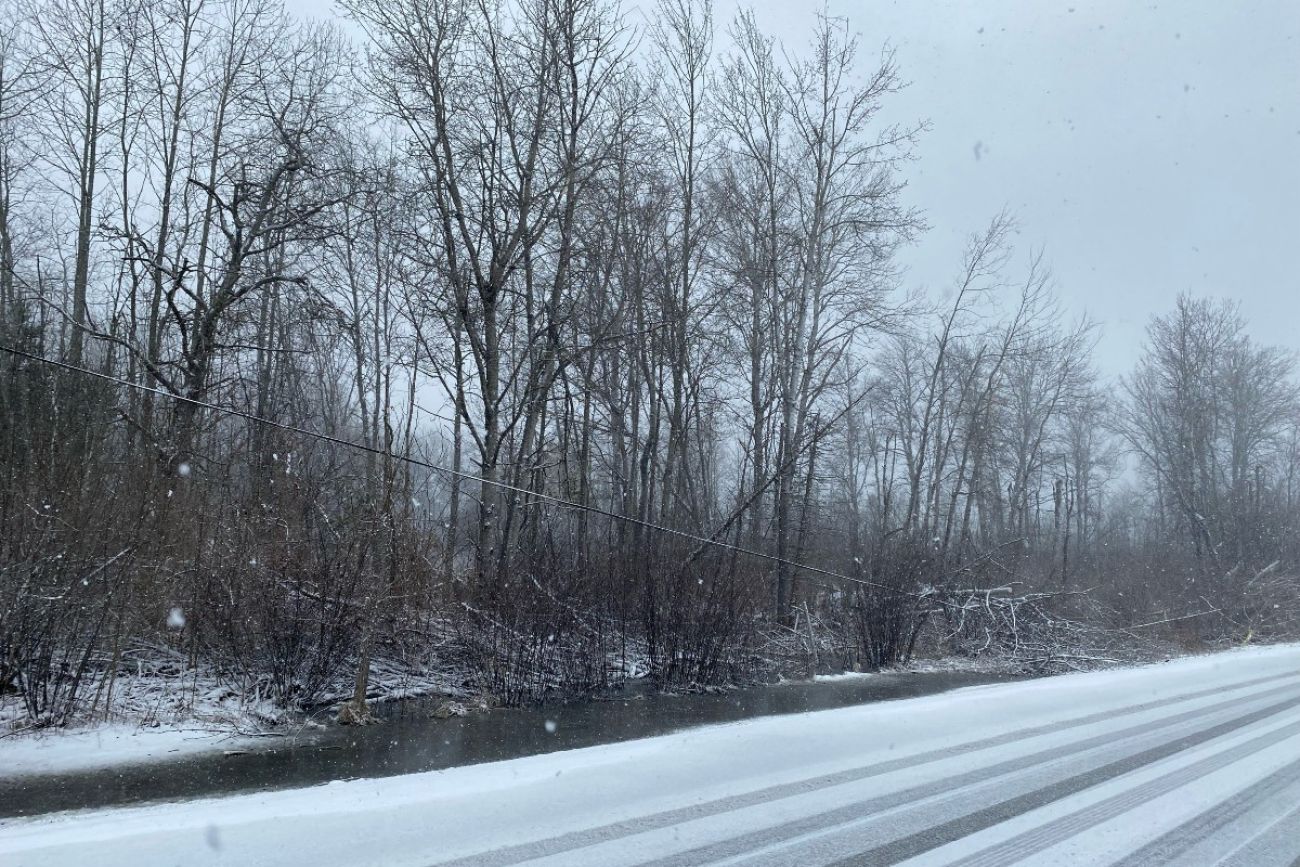Days after storms, thousands still without power. That’s the norm in Michigan

- More than 300,000 utility customers lost power Sunday; days later more than 70,000 remained without
- Michigan routinely has some of the nation’s longest power outages during major storms
- Utilities says recently approved rate hikes will improve reliability, but weather is becoming increasingly harsh
More than 70,000 Michigan utility customers remained without power on Friday, six days after a massive ice storm in the north and 10 tornadoes to the south downed scores of power lines and knocked out electricity for more than 300,000 customers.
While the state’s top energy regulator said he’d never seen such a storm, long power outages aren’t exactly an anomaly here.
In fact, Michigan consistently ranks among the top among states in the duration of power outages, according to data from the US Energy Information Administration.
Utility company executives blame more frequent and more severe weather in a tree-covered state, but critics such as the state attorney general say utilities are falling short.
Utility companies rely too much on rate increases to fund costly infrastructure upgrades, rather than more commonsense and effective solutions such as tree trimming, a spokesperson for state Attorney General Dana Nessel said.
“Simply put, (Nessel) supports funding improvements that enhance grid resilience and reliability, while DTE and Consumers Energy consistently propose ‘improvements’ to make themselves more profitable,” Nessel’s press secretary, Danny Wimmer, wrote in an email.
Brian Calka, vice president of electric distribution operations at DTE Energy, said technology and infrastructure improvements have already shortened the duration of outages. DTE invested $1.5 billion in upgrades last year.
The number of minutes DTE customers went without power declined 70% last year over the year before, he said.
While conceding 2024 had fewer major storms than 2023, Calka said “things are getting better due to the investments we’re making.”
Meanwhile, the state’s energy regulator, the Michigan Public Service Commission, has made improving the reliability of the state’s electric grid an “obsessive focus” over the last couple years, commission Chair Dan Scripps said.
The commission has in recent years approved new standards for how long outages should last and set new rules for how utilities can spend money from approved rate increases to ensure those dollars actually improve reliability, Scripps said.
Regulators historically haven’t focused on utilities’ responses to major storms, Scripps said, because companies can’t control the weather.
Now, in the face of changing weather, regulators are paying more attention.
“It’s never going to be perfect, but it can’t mean that every year is a historic year that we’ve never seen before,” Scripps said. “If that’s the case, it means we’re not keeping up with where we need to be.”
Left in the dark
Michigan’s outages during major storms lasted longer than the national average in nine out of the 11 years between 2013 and 2023, the most recent year federal data is available.
In 2023, Michigan had the nation’s third-longest average outage, at nearly 19 hours, according to the federal data. That year, Michigan had the 16th most frequent outages during major storms, at an average of about 1 ½ outages per customer.
Scripps, of the Public Service Commission, said regulators realized Michigan’s utilities performed worse than the national average, even controlling for the weather.
The commission in 2023 established new rules to encourage utilities to get power back on more quickly, including setting automatic credits for electric customers who lose power.
Currently, customers get $40 a day. Before the new rules, customers received a one-time $25 credit and had to ask for it to get it.
“The weather is changing,” Scripps said. “We’re seeing more severe weather more often. It means we’ve got to make sure we’re anticipating the changes that have happened and will happen.”

RELATED:
- Michigan near tops in nation for outages. Utilities want to raise rates
- Ann Arbor hopes to bring rooftop solar to the masses by creating a utility
- Michigan’s controversial wind, solar energy law is in effect. What to know
‘I wish it were easy’
DTE Energy, the state’s largest provider with more than 2 million electricity customers, aims to reduce the frequency of outages by 30% and the duration of outages by 50% by 2029, Calka said.
Consumers Energy, the state’s second-largest provider with nearly 2 million customers, aims to eventually ensure no outage affects more than 100,000 customers or lasts longer than 24 hours.
“Having that as our North Star allows us to say, ‘What do we need to be doing to get there?’” said Consumers spokesperson Tracy Wimmer.
Accomplishing those goals takes money, and that money comes from customers.
Just last month, the Public Service Commission approved a $154 million rate hike for Consumers Energy for reliability improvements, raising residential rates by about 3%.
In January, DTE got the green light for a $217 million rate hike, raising residential rates by about 5%.
That money will go toward tree-trimming, replacing wooden utility poles with more weather-resistant metal poles and technology such as sensors that can quickly identify the locations of outages. Other technology allows utilities to isolate problem spots and reenergize nearby customers before a line crew can arrive. Consumers has a device called Spot the Robot Dog that uses infrared to scan substations for potential outages so they can be preemptively repaired.
The average Michigander paid $111.56 per month on their electric bill, the 12th-most in the nation, according to industry watcher SaveOnEnergy.com.
Wimmer, the Nessel spokesperson, said the state’s regulatory structure allows utilities to bake company profits into its rate hike requests.
That “lures these for-profit corporations toward high-cost, high-frequency development projects, even when lower-cost initiatives or maintenance would have a larger impact on reliability.”
Utility officials disputed that, saying all of the investments are needed to truly harden the grid against the weather.
“I wish it were as easy as a silver bullet that I could point my money toward,” DTE’s Calka said.
“It can be a shocking number when we’re talking about rate increases, but the reality is that if we spend this money now, it helps us all in the long term,” said Consumer’s Tracy Wimmer.
Stopping a hurricane?
But will it be enough for what Mother Nature has in store?
Following last week’s storms, ice hung around on northern Michigan’s trees at least until Wednesday and continued to down limbs that sometimes took power lines with them.
The March 30 storm brought “record-breaking storm conditions,” said Allan Berg, CEO of the Presque Isle Electric & Gas Co-op in Presque Isle County, where nearly half of the more than 13,000 electric customers remained without power Friday afternoon. “I don’t know that you could avoid that.”
The company has a “robust” tree-clearing program, Berg said, working hard to maintain rights-of-way around utility lines, but those only reach so far. Berg noted that the storm brought down transmission lines, which sit higher and have broader rights-of-way than the distribution lines that take power to homes and businesses.
“When you see 20 or more trees down every mile of our system, you can’t prevent that,” Berg said. “It’s almost like asking, ‘What are you going to do to prevent the next hurricane?’ The only thing we could do would be putting everything underground, which would cost hundreds of millions of dollars.”
See what new members are saying about why they donated to Bridge Michigan:
- “In order for this information to be accurate and unbiased it must be underwritten by its readers, not by special interests.” - Larry S.
- “Not many other media sources report on the topics Bridge does.” - Susan B.
- “Your journalism is outstanding and rare these days.” - Mark S.
If you want to ensure the future of nonpartisan, nonprofit Michigan journalism, please become a member today. You, too, will be asked why you donated and maybe we'll feature your quote next time!




